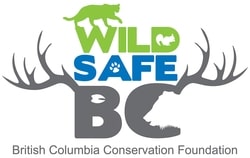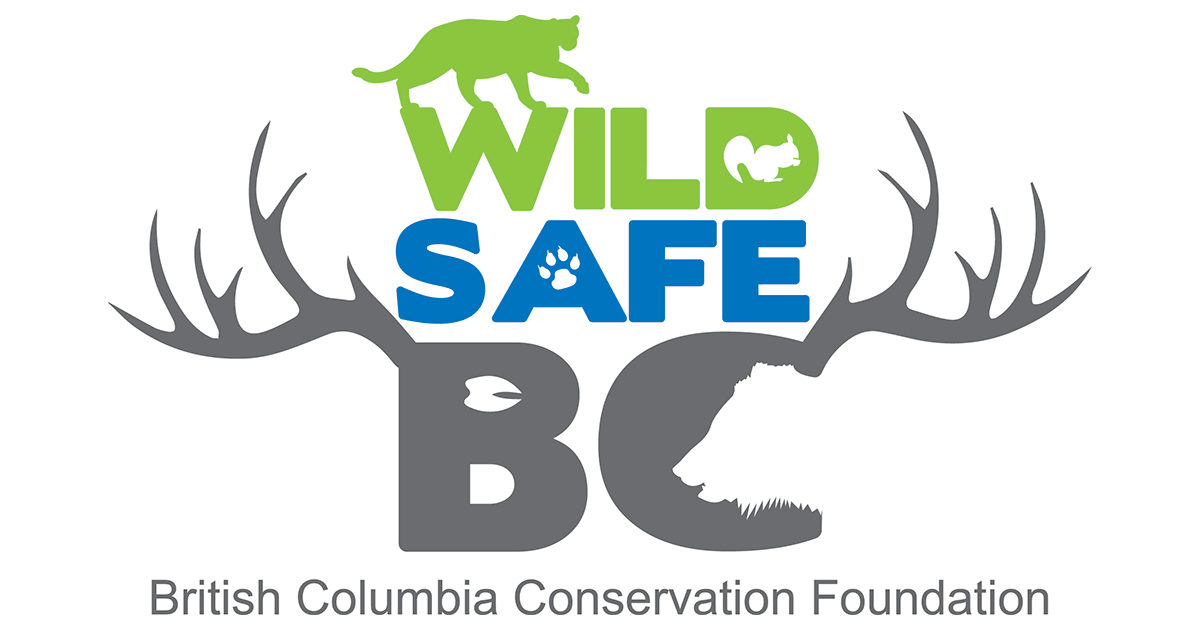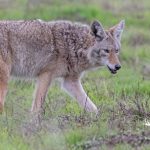Coyote
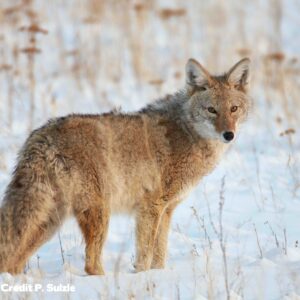 Coyote Snapshot
Coyote Snapshot
The coyote (Canis latrans) is a member of the dog family (Canidae) and is closely related to both the wolf and the domestic dog. The coyote’s range has increased since the arrival of Europeans and the reduction in wolf populations. Unlike wolves, coyotes are well-adapted to living close to human settlements. Coyotes are efficient hunters and can help control rodent populations.
Human-coyote conflicts can occur when they predate on young or small livestock or attack people’s pets. Free-ranging pets are at risk of coyote predation. While human attacks are rare, they can occur especially if coyotes become comfortable around humans and have received a food reward either through direct or indirect feeding. There are currently no reports of coyotes with rabies in BC.
On average, the Conservation Officer Service receives approximately 1,100 reports regarding coyotes every year. The majority are in urban areas such as the Lower Mainland and Central Okanagan. Coyote reports can increase slightly during coyote breeding season which begins in February. All coyote encounters that are aggressive in nature or show a lack of fear of people should be reported to the Conservation Officer Service at 1-877-952-7277.
Wild Coyote Facts
- Coyotes are efficient mousers and many farmers have come to appreciate the rodent control that a coyote family can provide
- Coyotes have greatly expanded their range with the arrival of Europeans that altered the landscape and reduced their predator – the wolf
- Coyotes are found throughout BC but they are absent from Vancouver Island
- Coyotes are opportunistic carnivores primarily feeding on rodents but they will also eat berries, crab apples, bird eggs, carrion and some vegetation
- Coyotes will prey on and potentially limit red fox populations
- Free-ranging pets or unprotected small livestock are at risk of coyote predation
- Coyotes primarily hunt alone or in pairs at night but are also known to hunt in family packs to bring down larger prey
- They can sprint up to 70km/hr and can swim well
- Coyotes are most active at dawn, dusk and at night but they can be seen at any time
Identification
Coyotes (Canis latrans) are the most numerous wild dog species in the province. Smaller than a wolf, yet larger than a red fox, mature coyotes in BC are 1 to 1.3 m long (including their tail) and weigh approximately 9 to 23 kg. They have a bushy black-tipped tail which is usually carried down when running unlike wolves that carry their tails out behind them. Coat colour varies geographically and can range from grey to reddish with darker areas along the back and lighter areas underneath. Compared to wolves, they have a slim pointed muzzle, tall prominent ears, long legs and small feet.
Biology
The coyote is a mid-sized wild dog species closely related to wolves and domestic dogs and has the ability to interbreed with these other species. Despite this close relationship, interbreeding is rare and there is little evidence of this occurring in the Western Coyote. The Eastern Coyote is considered a subspecies as individuals and populations have varying mixes of all three species. The term coywolf is highly disputed as it suggests a 50/50 wolf-coyote hybrid with little genetic evidence to support it.
Coyotes mate from late January to mid-March and will produce an average of five pups in April to mid-May after a 60-63 day gestation period. Litter size depends on food availability. Pups are most commonly born into dens dug into soil. They will take advantage of and expand holes or dens previously created by badgers, marmots, rabbits or rodents. Less commonly there are records of other sites being used such as logs, rock crevices or underbrush.
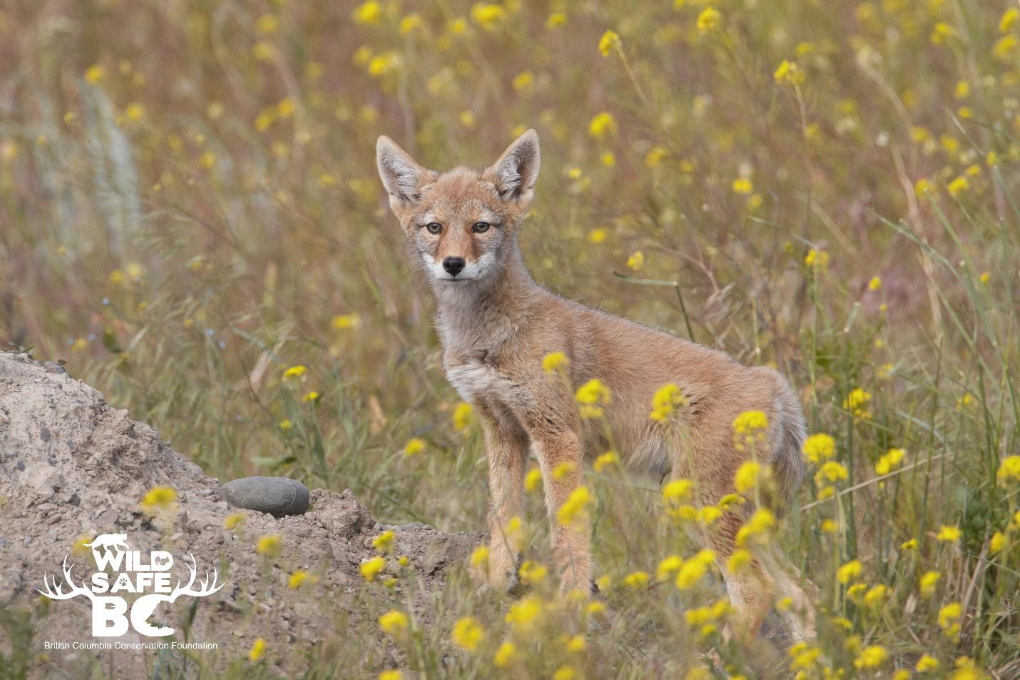
Like many other wild canids, both parents tend to the pups that are born helpless with eyes that do not open until 9 to 14 days of age. Pups do not emerge from the den until 3 weeks of age. When young are old enough to fend for themselves, at about 4 to 5 months of age, they disperse. Dispersal of pups occurs towards the end of fall, beginning of winter. In early winter more than 50 percent of the coyote population may be made up of juveniles.
The average life span of the coyote in the wild ranges from six to nine years. Natural predators of coyotes are wolves and cougars. Coyotes may also be struck and killed by vehicles and this may be a proportionately higher cause of mortality in urban centres. Coyotes may displace red foxes either through predation or direct competition.
Diet is made up primarily of small mammals such as mice, voles, ground squirrels, rabbits and hares and they can therefore provide effective pest control. Carrion can also make up a large portion of their diet, and is of particular importance for winter survival in many regions. Additionally they consume ungulate young, birds, insects, snakes, fish and plant matter including berries. Studies have shown that in some regions coyote predation on ungulate young particularly that of deer or bighorn sheep is the largest cause for ungulate young mortality. Coyote populations can be cyclical in areas where their primary food source is cyclical, such as those observed in snowshoe hares. This can cause local coyote populations to increase rapidly over short periods of time.
Where populations of coyotes are high, there may be increases in sarcoptic mange, canine distemper and canine parvovirus which can be transmitted to domestic dogs. Like other wildlife, coyotes can be hosts for a wide variety of parasites both internal and external.
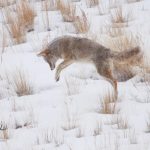 Behaviour
Behaviour
Coyotes may be observed throughout the day, however they commonly avoid threats by hunting at dusk, dawn and throughout the night. They use their acute sense of smell, hearing and vision to located prey. As rodent hunters, they can be observed “mousing” alone and will use their acute sense of hearing to locate rodents moving under the snow or grass. Once their prey is located, they may take a leap into the air and pounce on their prey with their front paws. They will also hunt in mating pairs or in packs of up to 10 related individuals. Like other canids, coyotes have complex and dynamic social structures and they will mark and defend their territories. Coyotes will yip and howl to announce their presence and territory to others.
Range and Habitat
Coyotes are found throughout mainland BC. They can adapt to a variety of habitats where they can find suitable prey but tend to avoid areas of dense wet forest or deep snow. In BC, their home ranges will vary between 10 to 40 km2 and will depend on prey availability and season.
WildSafe Tales Coyote Episode
In this video we observe coyotes hunting and also being chased. Coyote activity picks up during mating season and they can become protective of their dens when raising pups. When people and/or their pets are too close to their dens they may become more defensively more aggressive if approached. They may also defend their dens more passively by simply following intruders until they are a safe distance away. This is known as "escorting" behaviour.
Coyote Safety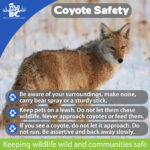
Coyote attacks on people are rare in BC but they can perceive pets on and off leash as a potential threat or prey. There have been reports of people, including children, bitten in North America and there has been one fatal human attack that occurred in Nova Scotia in 2009. In the event you encounter a coyote that behaves aggressively towards you or your pet:
- Make yourself appear large, maintain eye contact and speak in a low firm voice or shout
- Do not run or turn your back to it as this may trigger an attack
- Pick up small pets and children immediately; older children should stay close and not try to run away
- Wave your arms and if you have a walking stick or gardening implement such as a rake or shovel, be prepared to use it as a weapon against the coyote
- Throw rocks, sticks or other objects in the animal’s vicinity
- If the coyote continues to approach, do not run or turn your back on it, continue looking large and making noise while you slowly retreat. Move towards more people or into your home or vehicle
- If the coyote attacks, deliver a series of blows either with your feet or a sturdy stick at the animal’s ribs and stomach
- Bear spray can also be used in the event of an attack
- Report the encounter to the Conservation Officer Service
There have been records of coyotes becoming interested in and pursuing children, however, this is usually the result of habituated and food-conditioned coyotes during periods of low food availability. That being said, it is best not to leave small children unattended where they may encounter coyotes.
Keep dogs on leash and under control and avoid using extension leashes, especially with small dogs, when out in areas where coyotes are known to be. Coyotes will view small dogs as prey. Coyotes can be more aggressive towards your dog during mating season from February to March and when protecting dens and raising young. Do not allow your dog to interact with coyotes as this permits coyotes to become familiar with humans and pets and can lead to further conflicts.
As coyotes can be vectors for a variety of diseases, it is important never to handle deceased animals or droppings with bare hands. While coyotes can carry rabies, there are currently no reports of rabies in BC coyote populations.
Conflict Reduction with Coyotes
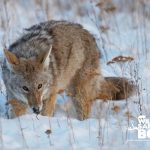 Cities provide increased food opportunities for coyotes, with the addition of garbage, pets, fruit, berries, compost, and bird seed. These attractants also support rodents that are a primary food source for coyotes. Green spaces provide adequate to excellent food, water and shelter opportunities with the additional benefit of reduced risk of depredation.
Cities provide increased food opportunities for coyotes, with the addition of garbage, pets, fruit, berries, compost, and bird seed. These attractants also support rodents that are a primary food source for coyotes. Green spaces provide adequate to excellent food, water and shelter opportunities with the additional benefit of reduced risk of depredation.
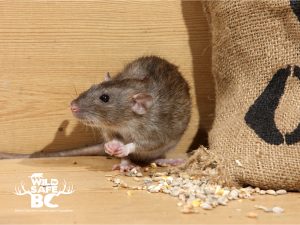 Avoid attracting coyotes to your property and community by following these best practices:
Avoid attracting coyotes to your property and community by following these best practices:
- Keep your pets either protected with fencing, supervised or kept indoors, especially at night. Cats and dogs that are left to free-range can become easy prey targets.
- Feed your pets indoors. Uneaten pet food can attract coyotes and other coyote prey species such as rodents.
- Pick up after your dog. Canine feces can act as an attractant for coyotes.
- Never feed wildlife including coyotes. The Provincial Wildlife Act considers it an offense to attract and/or feed dangerous wildlife which includes bears, wolves, cougars and coyotes.
- Keep all garbage secure. Clean garbage containers, and ensure that they have tight fitting secure lids or use bear-resistant bins. Do not place garbage out until the morning of pick up if your neighborhood has curbside pickup.
- Ensure your compost is working properly. Composts that emit strong odours are likely not working correctly.
- Pick up all fruit.
- Remove dense landscaping or low branches in your yards and in schoolyards as these provide cover for coyotes and opportunities to reside in our neighbourhoods. In addition, the spaces under our porches, sheds and decks can provide opportunities for hiding or denning. Use small wire mesh to seal off these areas and reduce the chance of attracting a coyote to your yard. Fences that are 2 m high can help exclude coyotes from your yard.
- Install motion activated lights or sprinklers.
- Bird feeders can also attract non-target species such as bears and rodents. Rodents will then attract coyotes.
If you keep chickens or small livestock use a properly installed and maintained electric fence that is maintained regularly and should follow WildSafeBC’s electric fencing guidelines. Store all of your feed in a secure rodent-proof location and ensure feeding areas are clean and free of attractants. Chicken coops and runs should be covered as many animals can leap or climb over fencing. Put small domestic livestock in an enclosed area at night. Use lighting around barns and pens to deter predators. Refer to Growing in Wildlife Country for more information on raising livestock in coyote habitat.
Coyote Resources
- BC Ecosystem Explorer
- Urban Coyote Research Project focused on urban human-coyote conflicts in Chicago, Illinois.
- Stanley Park Co-existing with Coyotes Project where local information and Lower Mainland sightings are available.
- Province of BC. Wolves and Coyotes.
 Coyote Snapshot
Coyote Snapshot
The coyote (Canis latrans) is a member of the dog family (Canidae) and is closely related to both the wolf and the domestic dog. The coyote’s range has increased since the arrival of Europeans and the reduction in wolf populations. Unlike wolves, coyotes are well-adapted to living close to human settlements. Coyotes are efficient hunters and can help control rodent populations.
Human-coyote conflicts can occur when they predate on young or small livestock or attack people’s pets. Free-ranging pets are at risk of coyote predation. While human attacks are rare, they can occur especially if coyotes become comfortable around humans and have received a food reward either through direct or indirect feeding. There are currently no reports of coyotes with rabies in BC.
On average, the Conservation Officer Service receives approximately 1,100 reports regarding coyotes every year. The majority are in urban areas such as the Lower Mainland and Central Okanagan. Coyote reports can increase slightly during coyote breeding season which begins in February. All coyote encounters that are aggressive in nature or show a lack of fear of people should be reported to the Conservation Officer Service at 1-877-952-7277.
Wild Coyote Facts
- Coyotes are efficient mousers and many farmers have come to appreciate the rodent control that a coyote family can provide
- Coyotes have greatly expanded their range with the arrival of Europeans that altered the landscape and reduced their predator – the wolf
- Coyotes are found throughout BC but they are absent from Vancouver Island
- Coyotes are opportunistic carnivores primarily feeding on rodents but they will also eat berries, crab apples, bird eggs, carrion and some vegetation
- Coyotes will prey on and potentially limit red fox populations
- Free-ranging pets or unprotected small livestock are at risk of coyote predation
- Coyotes primarily hunt alone or in pairs at night but are also known to hunt in family packs to bring down larger prey
- They can sprint up to 70km/hr and can swim well
- Coyotes are most active at dawn, dusk and at night but they can be seen at any time
Identification
Coyotes (Canis latrans) are the most numerous wild dog species in the province. Smaller than a wolf, yet larger than a red fox, mature coyotes in BC are 1 to 1.3 m long (including their tail) and weigh approximately 9 to 23 kg. They have a bushy black-tipped tail which is usually carried down when running unlike wolves that carry their tails out behind them. Coat colour varies geographically and can range from grey to reddish with darker areas along the back and lighter areas underneath. Compared to wolves, they have a slim pointed muzzle, tall prominent ears, long legs and small feet.
Biology
The coyote is a mid-sized wild dog species closely related to wolves and domestic dogs and has the ability to interbreed with these other species. Despite this close relationship, interbreeding is rare and there is little evidence of this occurring in the Western Coyote. The Eastern Coyote is considered a subspecies as individuals and populations have varying mixes of all three species. The term coywolf is highly disputed as it suggests a 50/50 wolf-coyote hybrid with little genetic evidence to support it.
Coyotes mate from late January to mid-March and will produce an average of five pups in April to mid-May after a 60-63 day gestation period. Litter size depends on food availability. Pups are most commonly born into dens dug into soil. They will take advantage of and expand holes or dens previously created by badgers, marmots, rabbits or rodents. Less commonly there are records of other sites being used such as logs, rock crevices or underbrush.

Like many other wild canids, both parents tend to the pups that are born helpless with eyes that do not open until 9 to 14 days of age. Pups do not emerge from the den until 3 weeks of age. When young are old enough to fend for themselves, at about 4 to 5 months of age, they disperse. Dispersal of pups occurs towards the end of fall, beginning of winter. In early winter more than 50 percent of the coyote population may be made up of juveniles.
The average life span of the coyote in the wild ranges from six to nine years. Natural predators of coyotes are wolves and cougars. Coyotes may also be struck and killed by vehicles and this may be a proportionately higher cause of mortality in urban centres. Coyotes may displace red foxes either through predation or direct competition.
Diet is made up primarily of small mammals such as mice, voles, ground squirrels, rabbits and hares and they can therefore provide effective pest control. Carrion can also make up a large portion of their diet, and is of particular importance for winter survival in many regions. Additionally they consume ungulate young, birds, insects, snakes, fish and plant matter including berries. Studies have shown that in some regions coyote predation on ungulate young particularly that of deer or bighorn sheep is the largest cause for ungulate young mortality. Coyote populations can be cyclical in areas where their primary food source is cyclical, such as those observed in snowshoe hares. This can cause local coyote populations to increase rapidly over short periods of time.
Where populations of coyotes are high, there may be increases in sarcoptic mange, canine distemper and canine parvovirus which can be transmitted to domestic dogs. Like other wildlife, coyotes can be hosts for a wide variety of parasites both internal and external.
 Behaviour
Behaviour
Coyotes may be observed throughout the day, however they commonly avoid threats by hunting at dusk, dawn and throughout the night. They use their acute sense of smell, hearing and vision to located prey. As rodent hunters, they can be observed “mousing” alone and will use their acute sense of hearing to locate rodents moving under the snow or grass. Once their prey is located, they may take a leap into the air and pounce on their prey with their front paws. They will also hunt in mating pairs or in packs of up to 10 related individuals. Like other canids, coyotes have complex and dynamic social structures and they will mark and defend their territories. Coyotes will yip and howl to announce their presence and territory to others.
Range and Habitat
Coyotes are found throughout mainland BC. They can adapt to a variety of habitats where they can find suitable prey but tend to avoid areas of dense wet forest or deep snow. In BC, their home ranges will vary between 10 to 40 km2 and will depend on prey availability and season.
WildSafe Tales Coyote Episode
In this video we observe coyotes hunting and also being chased. Coyote activity picks up during mating season and they can become protective of their dens when raising pups. When people and/or their pets are too close to their dens they may become more defensively more aggressive if approached. They may also defend their dens more passively by simply following intruders until they are a safe distance away. This is known as "escorting" behaviour.
Coyote Safety
Coyote attacks on people are rare in BC but they can perceive pets on and off leash as a potential threat or prey. There have been reports of people, including children, bitten in North America and there has been one fatal human attack that occurred in Nova Scotia in 2009. In the event you encounter a coyote that behaves aggressively towards you or your pet:
- Make yourself appear large, maintain eye contact and speak in a low firm voice or shout
- Do not run or turn your back to it as this may trigger an attack
- Pick up small pets and children immediately; older children should stay close and not try to run away
- Wave your arms and if you have a walking stick or gardening implement such as a rake or shovel, be prepared to use it as a weapon against the coyote
- Throw rocks, sticks or other objects in the animal’s vicinity
- If the coyote continues to approach, do not run or turn your back on it, continue looking large and making noise while you slowly retreat. Move towards more people or into your home or vehicle
- If the coyote attacks, deliver a series of blows either with your feet or a sturdy stick at the animal’s ribs and stomach
- Bear spray can also be used in the event of an attack
- Report the encounter to the Conservation Officer Service
There have been records of coyotes becoming interested in and pursuing children, however, this is usually the result of habituated and food-conditioned coyotes during periods of low food availability. That being said, it is best not to leave small children unattended where they may encounter coyotes.
Keep dogs on leash and under control and avoid using extension leashes, especially with small dogs, when out in areas where coyotes are known to be. Coyotes will view small dogs as prey. Coyotes can be more aggressive towards your dog during mating season from February to March and when protecting dens and raising young. Do not allow your dog to interact with coyotes as this permits coyotes to become familiar with humans and pets and can lead to further conflicts.
As coyotes can be vectors for a variety of diseases, it is important never to handle deceased animals or droppings with bare hands. While coyotes can carry rabies, there are currently no reports of rabies in BC coyote populations.
Conflict Reduction with Coyotes
 Cities provide increased food opportunities for coyotes, with the addition of garbage, pets, fruit, berries, compost, and bird seed. These attractants also support rodents that are a primary food source for coyotes. Green spaces provide adequate to excellent food, water and shelter opportunities with the additional benefit of reduced risk of depredation.
Cities provide increased food opportunities for coyotes, with the addition of garbage, pets, fruit, berries, compost, and bird seed. These attractants also support rodents that are a primary food source for coyotes. Green spaces provide adequate to excellent food, water and shelter opportunities with the additional benefit of reduced risk of depredation.
 Avoid attracting coyotes to your property and community by following these best practices:
Avoid attracting coyotes to your property and community by following these best practices:
- Keep your pets either protected with fencing, supervised or kept indoors, especially at night. Cats and dogs that are left to free-range can become easy prey targets.
- Feed your pets indoors. Uneaten pet food can attract coyotes and other coyote prey species such as rodents.
- Pick up after your dog. Canine feces can act as an attractant for coyotes.
- Never feed wildlife including coyotes. The Provincial Wildlife Act considers it an offense to attract and/or feed dangerous wildlife which includes bears, wolves, cougars and coyotes.
- Keep all garbage secure. Clean garbage containers, and ensure that they have tight fitting secure lids or use bear-resistant bins. Do not place garbage out until the morning of pick up if your neighborhood has curbside pickup.
- Ensure your compost is working properly. Composts that emit strong odours are likely not working correctly.
- Pick up all fruit.
- Remove dense landscaping or low branches in your yards and in schoolyards as these provide cover for coyotes and opportunities to reside in our neighbourhoods. In addition, the spaces under our porches, sheds and decks can provide opportunities for hiding or denning. Use small wire mesh to seal off these areas and reduce the chance of attracting a coyote to your yard. Fences that are 2 m high can help exclude coyotes from your yard.
- Install motion activated lights or sprinklers.
- Bird feeders can also attract non-target species such as bears and rodents. Rodents will then attract coyotes.
If you keep chickens or small livestock use a properly installed and maintained electric fence that is maintained regularly and should follow WildSafeBC’s electric fencing guidelines. Store all of your feed in a secure rodent-proof location and ensure feeding areas are clean and free of attractants. Chicken coops and runs should be covered as many animals can leap or climb over fencing. Put small domestic livestock in an enclosed area at night. Use lighting around barns and pens to deter predators. Refer to Growing in Wildlife Country for more information on raising livestock in coyote habitat.
Coyote Resources
- BC Ecosystem Explorer
- Urban Coyote Research Project focused on urban human-coyote conflicts in Chicago, Illinois.
- Stanley Park Co-existing with Coyotes Project where local information and Lower Mainland sightings are available.
- Province of BC. Wolves and Coyotes.
